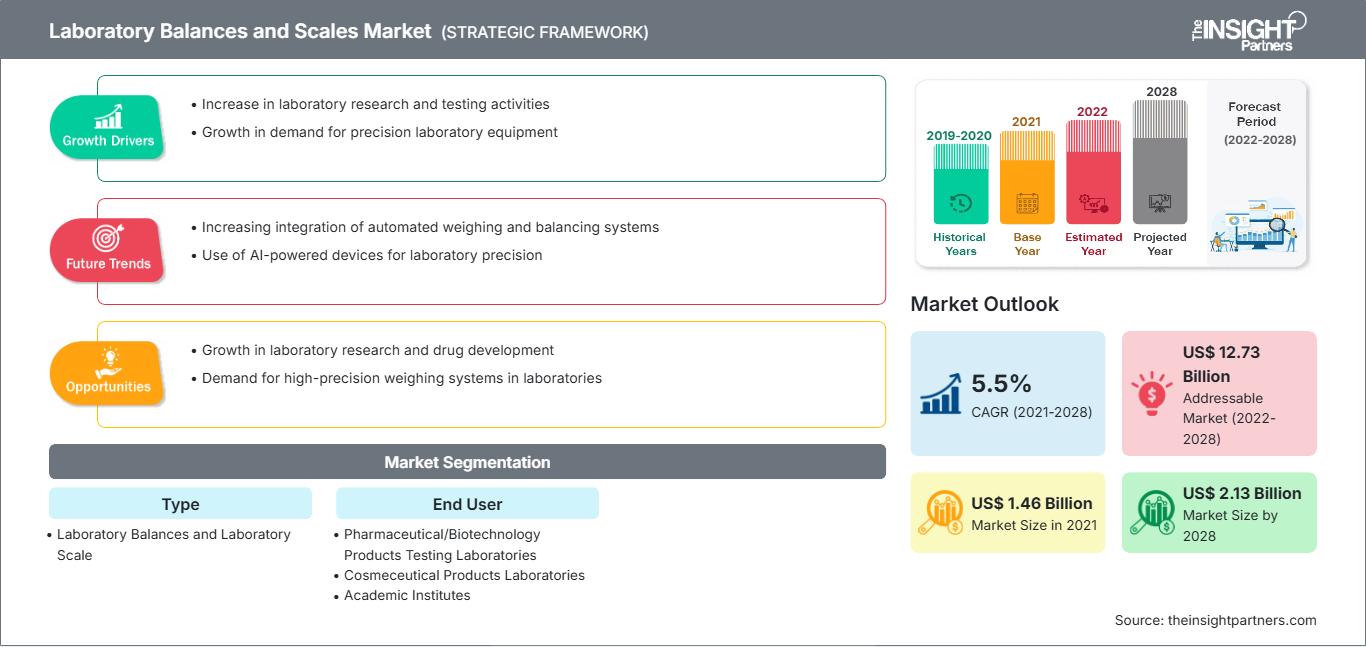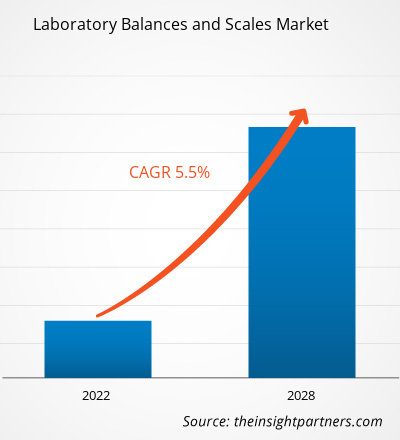Si prevede che il mercato delle bilance da laboratorio raggiungerà i 2.131,14 milioni di dollari nel 2028, rispetto ai 1.463,53 milioni di dollari del 2021. Si stima che il mercato crescerà con un CAGR del 5,5% dal 2021 al 2028.
L'ambito del mercato delle bilance da laboratorio include tipologia, utente finale e regione. Il mercato delle bilance da laboratorio, in base alla regione, è segmentato in Nord America, Europa, Asia-Pacifico, Medio Oriente e Africa e Sud e Centro America. Il rapporto offre approfondimenti e analisi approfondite del mercato delle bilance da laboratorio, sottolineando vari parametri come tendenze di mercato, progressi tecnologici, dinamiche di mercato e analisi del panorama competitivo dei principali attori del mercato in tutto il mondo. Include anche un'analisi dell'impatto del COVID-19 in tutte le regioni.
Personalizza questo rapporto in base alle tue esigenze
Potrai personalizzare gratuitamente qualsiasi rapporto, comprese parti di questo rapporto, o analisi a livello di paese, pacchetto dati Excel, oltre a usufruire di grandi offerte e sconti per start-up e università
Mercato delle bilance e delle scale da laboratorio: Approfondimenti strategici

-
Ottieni le principali tendenze chiave del mercato di questo rapporto.Questo campione GRATUITO includerà l'analisi dei dati, che vanno dalle tendenze di mercato alle stime e alle previsioni.
Le infrastrutture sanitarie stanno assistendo a una forte crescita del numero di sperimentazioni cliniche e pipeline di ricerca in tutto il mondo. La sperimentazione clinica è un passaggio cruciale e significativo per valutare la sicurezza e l'efficacia di una strategia medica, di un trattamento o di un dispositivo per uso commerciale. Questi studi aiutano anche a comprendere e determinare i migliori approcci medici per una particolare area terapeutica. Le sperimentazioni cliniche vengono condotte principalmente per raccogliere dati sulla sicurezza e l'efficacia di un nuovo farmaco e dello sviluppo di un dispositivo. Prima dell'approvazione delle molecole farmacologiche o dei dispositivi medici da parte delle autorità di regolamentazione, vengono condotti una serie di studi clinici.
Numero di studi registrati per sperimentazioni cliniche|
Anno di prima pubblicazione |
Studi all'inizio dell'anno |
Studi durante l'anno |
Studi alla fine dell'anno Anno |
|
2015 |
181.304 |
24.130 |
205.434 |
|
2016 |
205.434 |
27.809 |
233.243 |
|
2017 |
233.243 |
29.198 |
262.441 |
|
2018 |
262.441 |
17.836 |
280.277 |
|
2019 |
293.275 |
32.519 |
325.794 |
|
2020 |
325.794 |
36.740 |
362.534 |
Fonte: Analisi di Clinical Trials.gov e The Insight Partners
Pertanto, il crescente numero di studi clinici accelera la domanda di strumenti e attrezzature di laboratorio, che in ultima analisi guiderà il mercato delle bilance da laboratorio durante il periodo di previsione.
Approfondimenti basati sulla tipologia
Il mercato delle bilance da laboratorio, per tipologia, è segmentato in bilance da laboratorio e bilance da laboratorio. Il segmento delle bilance da laboratorio è ulteriormente suddiviso in bilance analitiche, bilance a caricamento dall'alto/di precisione, micro e ultramicro bilance, bilance per umidità, bilance portatili e altre bilance. Il segmento delle bilance da laboratorio è ulteriormente suddiviso in bilance da banco, bilance contapezzi, bilance compatte e altre bilance. Il segmento delle bilance da laboratorio ha detenuto la quota di mercato maggiore nel 2021, mentre si prevede che lo stesso segmento registrerà il CAGR più elevato del mercato, pari al 5,8%, durante il periodo di previsione.
Approfondimenti regionali sul mercato delle bilance e delle piattaforme da laboratorio
Le tendenze regionali e i fattori che influenzano il mercato delle bilance da laboratorio durante il periodo di previsione sono stati ampiamente spiegati dagli analisti di The Insight Partners. Questa sezione illustra anche i segmenti e la geografia del mercato delle bilance da laboratorio in Nord America, Europa, Asia-Pacifico, Medio Oriente e Africa, America meridionale e centrale.
Ambito del rapporto di mercato sulle bilance e sulle piattaforme da laboratorio
| Attributo del rapporto | Dettagli |
|---|---|
| Dimensioni del mercato in 2021 | US$ 1.46 Billion |
| Dimensioni del mercato per 2028 | US$ 2.13 Billion |
| CAGR globale (2021 - 2028) | 5.5% |
| Dati storici | 2019-2020 |
| Periodo di previsione | 2022-2028 |
| Segmenti coperti |
By Tipo
|
| Regioni e paesi coperti |
Nord America
|
| Leader di mercato e profili aziendali chiave |
|
Densità degli operatori del mercato delle bilance da laboratorio: comprendere il suo impatto sulle dinamiche aziendali
Il mercato delle bilance da laboratorio è in rapida crescita, trainato dalla crescente domanda degli utenti finali, dovuta a fattori quali l'evoluzione delle preferenze dei consumatori, i progressi tecnologici e una maggiore consapevolezza dei vantaggi del prodotto. Con l'aumento della domanda, le aziende stanno ampliando la propria offerta, innovando per soddisfare le esigenze dei consumatori e sfruttando le tendenze emergenti, alimentando ulteriormente la crescita del mercato.

- Ottieni il Mercato delle bilance e delle scale da laboratorio Panoramica dei principali attori chiave
In base alle indicazioni, il mercato delle bilance da laboratorio comprende laboratori di analisi di prodotti farmaceutici e biotecnologici, laboratori di prodotti cosmeceutici, istituti accademici e laboratori di ricerca. I laboratori di analisi di prodotti farmaceutici e biotecnologici hanno detenuto la quota maggiore del mercato nel 2020 e si stima che lo stesso segmento registrerà il CAGR più elevato, pari al 6,7%, durante il periodo di previsione.
Strategie inorganiche come partnership, fusioni e acquisizioni sono comunemente adottate dalle aziende per soddisfare la mutevole domanda dei clienti e mantenere il proprio marchio in tutto il mondo. Gli operatori del mercato che operano nel mercato delle bilance da laboratorio adottano anche strategie organiche come il lancio e l'espansione dei prodotti per ampliare la propria presenza e il portafoglio prodotti in tutto il mondo e per soddisfare la crescente domanda.
Per tipo
- Bilance da laboratorio
- Bilance analitiche
- Bilance a caricamento dall'alto/di precisione
- Micro e ultramicro bilance
- Bilance per l'umidità
- Bilance portatili
- Altre bilance
- Bilance da laboratorio
- Bilance da banco
- Bilance contapezzi
- Bilance compatte
- Altre bilance
Per utente finale
- Laboratori di analisi di prodotti farmaceutici e biotecnologici
- Prodotti cosmeceutici Laboratori
- Istituti accademici
- Laboratori di ricerca
Per area geografica
- Nord America
- Stati Uniti
- Canada
- Messico
- Europa
- Francia
- Germania
- Italia
- Regno Unito
- Spagna
- Resto d'Europa
- Asia Pacifico (APAC)
- Cina
- India
- Corea del Sud
- Giappone
- Australia
- Resto dell'APAC
- Medio Oriente e Africa (MEA)
- Sudafrica
- Arabia Saudita
- Emirati Arabi Uniti
- Resto del MEA
- America del Sud e Centro (SCAM)
- Brasile
- Argentina
- Resto dello SCAM
Profili aziendali
- METTLER TOLEDO
- Sartorius AG
- PCE Instruments
- OHAUS
- Adam Equipment Ltd
- GRAM PRECISION
- RADWAG Balances and Scales
- Scientech Inc.
- BONSO Electronics International Inc.
- A&D Company, Limited
- Analisi storica (2 anni), anno base, previsione (7 anni) con CAGR
- Analisi PEST e SWOT
- Valore/volume delle dimensioni del mercato - Globale, Regionale, Nazionale
- Industria e panorama competitivo
- Set di dati Excel
Report recenti
Testimonianze
Motivo dell'acquisto
- Processo decisionale informato
- Comprensione delle dinamiche di mercato
- Analisi competitiva
- Analisi dei clienti
- Previsioni di mercato
- Mitigazione del rischio
- Pianificazione strategica
- Giustificazione degli investimenti
- Identificazione dei mercati emergenti
- Miglioramento delle strategie di marketing
- Aumento dell'efficienza operativa
- Allineamento alle tendenze normative






















 Ottieni un campione gratuito per - Mercato delle bilance e delle scale da laboratorio
Ottieni un campione gratuito per - Mercato delle bilance e delle scale da laboratorio